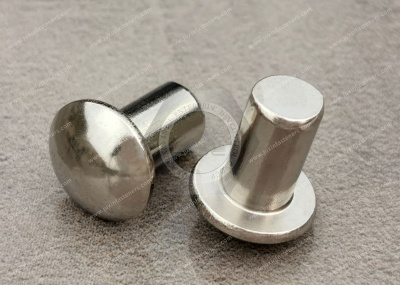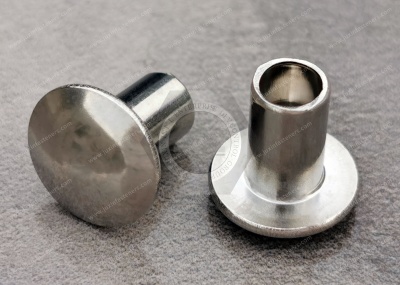Call Us
+86 136 6007 9809
Call Us
+86 136 6007 9809
Oct. 22, 2024
Hull 18-8 Stainless Steel Domed Head Solid Rivets
Method of connecting the hull and parts with rivets. There are hot riveting and cold riveting. Steel rivets with a diameter greater than 10 mm are generally hot riveted; small-diameter steel and aluminum alloy rivets are mostly cold riveted.


Usage
When riveting, first impact or drill the rivet holes on the connected parts, align the parts and temporarily clamp the holes with bolts to position them. Then, insert the red-hot rivets in a thermoplastic state into the rivet holes, and use a rivet gun to rust the nail tail into a nail head so that the overlapping parts are tightly connected, which is hot riveting. Cold riveting does not require the rivets to be heated to red before riveting. Riveting has low production efficiency, high labor intensity, and high noise and has been replaced by welding in steel ship construction. However, riveting is sometimes still used for parts with significant vibrations or prone to cracks. Riveting is sometimes used for the connection of different metals, and riveting is also used for ship superstructures built with aluminum alloys.
Scope of use
1. Scope of use of riveting for steel hulls
With the development of welding technology and the improvement of steel performance, the scope of use of riveted structures in modern ships has been narrowing. Since the backward riveting process can no longer meet the needs of contemporary shipbuilding, practical design, and process measures must be taken to completely replace riveted structures with welded structures. Therefore, the current "Classification and Construction Specifications for Steel Seagoing Ships" in my country and similar "Specifications" in major shipbuilding countries in the world no longer include the content of riveted structures.
The provisions on riveted structures in the "Steel Seagoing Ship Construction Specifications." Its scope of use is:
1. In addition to welding, the connection between the side plate and the deck side plate can also be riveted with side angle steel or side flat steel when the ship length is greater than 90m;
2. Used for non-tight connections of local wall structures inside superstructures.
The purpose of introducing the old regulations is only to provide technicians with relevant technical information in my country for reference when needed.
2. Scope of application of aluminum alloy hull riveting
Aluminum alloy riveting can be used in the following parts according to design requirements:
(1) Connection of aluminum alloy hull main structure;
(2) Connection of aluminum alloy superstructure.
Hull riveting seam types
1. Strong seam
Features: It requires high connection strength but does not require water tightness. It is used to connect frames and some structures inside the superstructure.
2. Tight seam
Features: It requires watertightness (or oiltightness, airtightness) but does not require excessive strength. It is used in the connection between the outer wall and stiffener of the aluminum alloy hull superstructure and the connection of the cabin structure inside the main hull.
3. Strong and tight seam
18-8 Stainless Steel Domed Head Solid Rivets
18-8 Stainless Steel Flush-Mount Solid Rivets
18-8 Stainless Steel Flat Head Solid Rivets
Aluminum Flush-Mount Solid Rivets
Aluminum Domed Head Solid Rivets
Aluminum Flat Head Solid Rivets
Features: requires both high connection strength and water tightness (or oil tightness, airtightness); Used in: connection of aluminum alloy hull main structure, connection of steel hull side
If you are looking for high-quality 18-8 Stainless Steel Domed Head Solid rivets and fasteners or technical support for structural design, please get in touch with me. Thanks.Email:adelajonly@gmail.com
Website: https://www.juxinfasteners.com
Contact Us
Tel.:
+86 020 8621 0320
+86 020 3121 6067
Technical Support:
Navigation
SEND INQUIREY